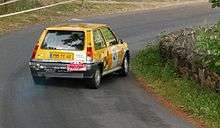Group N
In relation to motorsport governed by the FIA, Group N referred to a set of regulations providing 'standard' production vehicles for competition, often referred to as the "Showroom Class".
This contrasted with the Group A all-out competition production-derived vehicles. Group N cars are limited in terms of modifications made from standard specification. Group N was introduced by the FIA in 1982 to replace the outgoing Group 1 as "standard touring cars".
To qualify for homologation, a minimum of 2500 cars of the competing model had to be built in one year, out of 25,000 for the entire range of the model (e.g.: 2500 Subaru Impreza WRX, out of 25,000 Subaru Impreza).
The Group N regulations were officially replaced in 2013.[1] No new cars were homologated under Group A or Group N regulations, and instead existing cars were reclassified according to Group R rules (specifically the R4 class). The R4 class itself was gradually phased out.[1]
In 2015, the FIA realigned the rally classes yet again, finalizing the phase-out of R4.[2] A new class, NR4 was added, identical to the previous Group N class, just with a new name to fit in with the other "R" names. R4 cars were then not allowed in FIA sanctioned rallies in Europe, but since R4 was basically a transition group for old Group N, many of those could likely be re-homologated as NR4.
Road racing

While Group A became the standard category for international touring car racing, Group N found a home as a more economic class in national touring car racing. In many countries, there would often be two touring car championships, one for Group A and one for Group N. The category had some brief success with the demise of the Supertouring class in the late 1990s, when a few national regulations were relaxed to allow a greater number of modifications, in the guise of Super Production.
Endurance racing
The category is still used in circuit racing all over the world, notably in Japan which has the long running Super Taikyu (スーパー耐久, Super Taikyu, translated as Super Endurance), as well as in the Italian ETCS endurance series run by Peroni Promotion, but was once again relegated to a secondary status with the introduction of Super 2000, the class of cars currently run in the World Touring Car Championship.
Rallying

In Rallying, the Production World Rally Championship was run under Group N rules until 2012. The cars used were modified road cars, often based on turbocharged, four wheel drive versions of standard small cars such as the Subaru Impreza WRX and the Mitsubishi Lancer Evolution, although a wide range of vehicles were homologated by the FIA for use in Group N.
In the reform of the support category in 2013 season, the Group N4's car was one of the eligible cars in WRC-2 Category, considering its competitiveness to the other type of cars like Super 2000 and Group R cars in the category, there will also be a FIA Production Car Cup among N4 cars in WRC-2, (although, under new group R rules, no new Group N cars will be homologated by FIA and will be phased out in the future.)
Apart from FIA sanctioned events, many rallies at national levels are run under Group N. Some local variants of Group N have been created to allow other marques to compete where Group N is the national formula.
Allowed modifications
The range of modifications allowed was quite narrow - few mechanical engine modifications were allowed (save for lightening within set limits and baffled sumps) although the choice of ECU was free, and this could liberate some extra power itself, and most of the modifications allowed were to promote longevity rather than increased performance, although the boundaries of these two areas were blurring towards the end of the group's lifespan. Furthermore, cars with forced induction engines were fitted with a restrictor in front of the charger to limit power.[3]
Originally, Group N meant that all the interior trim had to be present (including the rear seat), but it later changed to allow removal of the trim aside from the dashboard and replacement of the door trim. The springs and dampers were free, as are the internals of the gearbox and the final-drive ratio, providing that the homologated gear ratios and gear change pattern were respected. This allowed the use of dog-engagement gearboxes, providing quicker gearchanges and longer gearbox life. There was provision for strengthening of the suspension components and bodyshell, provided this didn't alter the operating principle.[4]
The FIA and many national motorsport associations were moving towards making rallying championships based in Group N (until it was replaced by Group R), in an attempt to reduce costs, reinforce the link between motorsport and the car that the member of the public drives, and to reduce the environmental impact of motorsport. The GpN 4WD Turbo rally car category underwent the process of being renamed as R4 for 2011. The key areas were that standard road car bodywork and driven wheels were retained from the road car that could be bought from the showroom.
References
- "Specific regulations for cars in Groups R" (PDF). FIA.com. Fédération Internationale de l'Automobile. 19 May 2012. Retrieved 13 October 2014.
- "FIA WRC PRODUCTION RALLYING CLASS CHANGES IN 2015". dirtyimpreza.com. Retrieved 2015-06-18.
- Subaru parts lists for the Group N base car (PDF) Archived 2009-12-29 at the Wayback Machine
- Group N Cars as described in rallycars.com